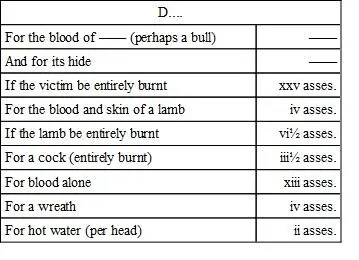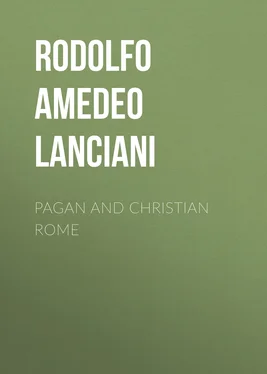Rodolfo Amedeo Lanciani - Pagan and Christian Rome
Здесь есть возможность читать онлайн «Rodolfo Amedeo Lanciani - Pagan and Christian Rome» — ознакомительный отрывок электронной книги совершенно бесплатно, а после прочтения отрывка купить полную версию. В некоторых случаях можно слушать аудио, скачать через торрент в формате fb2 и присутствует краткое содержание. Жанр: foreign_edu, История, История, на английском языке. Описание произведения, (предисловие) а так же отзывы посетителей доступны на портале библиотеки ЛибКат.
- Название:Pagan and Christian Rome
- Автор:
- Жанр:
- Год:неизвестен
- ISBN:нет данных
- Рейтинг книги:3 / 5. Голосов: 1
-
Избранное:Добавить в избранное
- Отзывы:
-
Ваша оценка:
- 60
- 1
- 2
- 3
- 4
- 5
Pagan and Christian Rome: краткое содержание, описание и аннотация
Предлагаем к чтению аннотацию, описание, краткое содержание или предисловие (зависит от того, что написал сам автор книги «Pagan and Christian Rome»). Если вы не нашли необходимую информацию о книге — напишите в комментариях, мы постараемся отыскать её.
Pagan and Christian Rome — читать онлайн ознакомительный отрывок
Ниже представлен текст книги, разбитый по страницам. Система сохранения места последней прочитанной страницы, позволяет с удобством читать онлайн бесплатно книгу «Pagan and Christian Rome», без необходимости каждый раз заново искать на чём Вы остановились. Поставьте закладку, и сможете в любой момент перейти на страницу, на которой закончили чтение.
Интервал:
Закладка:
A descriptive catalogue of these valuables and works of art was kept in each temple, and sometimes engraved on marble. The inventories included also the furniture and properties of the sacristy. In 1871 the following remarkable document was discovered in the Temple of Diana Nemorensis. The inventory, engraved on a marble pillar three feet high, is now preserved in the Orsini Castle at Nemi. It has been published by Henzen in "Hermes," vol. vi. p. 8, and reads as follows, in translation:—
Objects offered to [or belonging to] both temples [the temple of Isis and that of Bubastis]:—Seventeen statues; one head of the Sun; four silver images; one medallion; two bronze altars; one tripod (in the shape of one at Delphi); a cup for libations; a patera; a diadem [for the statue of the goddess] studded with gems; a sistrum of gilded silver; a gilt cup; a patera ornamented with ears of corn; a necklace studded with beryls; two bracelets with gems; seven necklaces with gems; nine ear-rings with gems; two nauplia [rare shells from the Propontis]; a crown with twenty-one topazes and eighty carbuncles; a railing of brass supported by eight hermulæ ; a linen costume comprising a tunica, a pallium, a belt, and a stola, all trimmed with silver; a like costume without trimming.
[Objects offered] to Bubastis:—A costume of purple silk; another of turquoise color; a marble vase with pedestal; a water jug; a linen costume with gold trimmings and a golden girdle; another of plain white linen.
The objects described in this catalogue did not belong to the Temple of Diana itself, one of the wealthiest in central Italy; but to two small shrines, of Isis and Bubastis, built by a devotee within the sacred enclosure, on the north side of the square.
The ancients displayed remarkably bad taste in loading the statues of their gods with precious ornaments, and in spoiling the beauty of their temples with hangings of every hue and description. A document published by Muratori 35speaks of a statue of Isis which was dedicated by a lady named Fabia Fabiana as a memorial to her deceased granddaughter Avita. The statue, cast in silver, weighed one hundred and twelve and a half pounds, and was muffled in ornaments and jewelry beyond conception. The goddess wore a diadem in which were set six pearls, two emeralds, seven beryls, one carbuncle, one hyacinthus , and two flint arrow-heads; also earrings with emeralds and pearls, a necklace composed of thirty-six pearls and eighteen emeralds, two clasps, two rings on the little finger, one on the third, one on the middle finger; and many other gems on the shoes, ankles, and wrists. Another inscription discovered at Constantine, Algeria, describes a statue of Jupiter dedicated in the Capitol of that city. The devotees had placed on his head an oak-wreath of silver, with thirty leaves and fifteen acorns; they had loaded his right hand with a silver disk, a Victory waving a palm-leaf, and a crown of forty leaves; and in the other had fastened a silver rod and other emblems.
The hangings and tinsel not only disfigured the interior of temples, but were a source of danger from their combustibility. When we hear of fires destroying the Pantheon in a. d. 110, the Temple of Apollo in 363, that of Venus and Rome in 307, and that of Peace in 191, we may assume that they were started and fed by the inflammable materials with which the interiors were filled. There is no other explanation to be given, inasmuch as the structures were fire-proof, with the exception of the roof. As for the disfiguration of sacred buildings with all sorts of hangings, it is enough to quote the words of Livy (xl. 51). "In the year of Rome, 574, the censors M. Fulvius Nobilior and M. Æmilius Lepidus restored the temple of Jupiter on the Capitol. On this occasion they removed from the columns all the tablets, medallions, and military flags omnis generis which had been hung against them."
The right of performing sacrifices was sometimes granted to civilians, on payment of a fee. An inscription discovered among the ruins of the Temple of Malakbelos, outside the Porta Portese, on the site of the new railway station, relates how an importer of wine, Quintus Octavius Daphnicus, having built at his own expense a banqueting hall within the sacred enclosure, was rewarded with the immunitas sacrum faciendi , that is, the right of performing sacrifices without the assistance of priests. The performances were regulated by tariffs, which specified a price for every item; and one of these has actually survived to our day. 36


The meaning of this tariff will be easily understood if we recall the details of a Græco-Roman sacrifice, in regard to the apportionment of the victim's flesh. The parts which were the perquisite of the priests differ in different worships; sometimes we hear of legs and skin, sometimes of tongue and shoulder. In the case of private sacrifices the rest of the animal was taken home by the sacrificer, to be used for a meal or sent as a present to friends. This was, of course, impossible in the case of "holocausts," in which the victim was burnt whole on the altar. In the Roman ritual, hides and skins were always the property of the temple. 37In the above tariff two prices are charged: a smaller one for ordinary sacrifices, when only the intestines were burnt, and the rest of the flesh was taken home by the sacrificer; a larger one for "holocausts," which required a much longer use of the altar, spit, gridiron, and other sacrificial instruments. Four asses are charged for each crown or wreath of flowers, half that amount for hot water.
The site of a sanctuary can be determined not only from its actual ruins, but, in many cases, from the contents of its favissæ , or vaults, which are sometimes collected in a group, sometimes spread over a considerable space of ground. The origin of these deposits of terra-cotta or bronze votive objects is as follows:—
Each leading sanctuary or place of pilgrimage was furnished with one or more rooms for the exhibition and safe-keeping of ex-votos. The walls of these rooms were studded with nails on which ex-voto heads and figures were hung in rows by means of a hole on the back. There were also horizontal spaces, little steps like those of a lararium , or shelves, on which were placed those objects that could stand upright. When both surfaces were filled, and no room was left for the daily influx of votive offerings, the priests removed the rubbish of the collection, that is, the terra-cottas, and buried them either in the vaults ( favissæ ) of the temple, or in trenches dug for the purpose within or near the sacred enclosure.
During these last years I have been present at the discovery of five deposits of ex-votos, each marking the site of a place of pilgrimage. The first was found in March, 1876, on the site of a temple of Hercules, outside the Porta S. Lorenzo; the second in the spring of 1885, on the site of the Temple of Diana Nemorensis; the third in 1886, near the Island of Æsculapius (now of S. Bartolomeo); the fourth in 1887, near the shrine of Minerva Medica; the last in 1889, on the site of the Temple of Juno at Veii.
The existence of a temple of Hercules, outside the Porta S. Lorenzo, within the enclosure of the modern cemetery, was first made known in 1862, in consequence of the discovery of an altar raised to him by Marcus Minucius, the "master of the horse" or lieutenant-general of Q. Fabius Maximus (217 b. c.). This altar is now exhibited in the Capitoline Museum. 38Fourteen years later, in 1876, the favissæ of the temple were found in the section of the cemetery called the Pincio. There were about two hundred pieces of terra-cotta, vases of Etruscan and Italo-Greek manufacture; several statuettes of bronze, and pieces of æs rude , and æs grave librale , one of them from the town of Luceria. This deposit seems to have been buried at the beginning of the sixth century of Rome.
Читать дальшеИнтервал:
Закладка:
Похожие книги на «Pagan and Christian Rome»
Представляем Вашему вниманию похожие книги на «Pagan and Christian Rome» списком для выбора. Мы отобрали схожую по названию и смыслу литературу в надежде предоставить читателям больше вариантов отыскать новые, интересные, ещё непрочитанные произведения.
Обсуждение, отзывы о книге «Pagan and Christian Rome» и просто собственные мнения читателей. Оставьте ваши комментарии, напишите, что Вы думаете о произведении, его смысле или главных героях. Укажите что конкретно понравилось, а что нет, и почему Вы так считаете.












